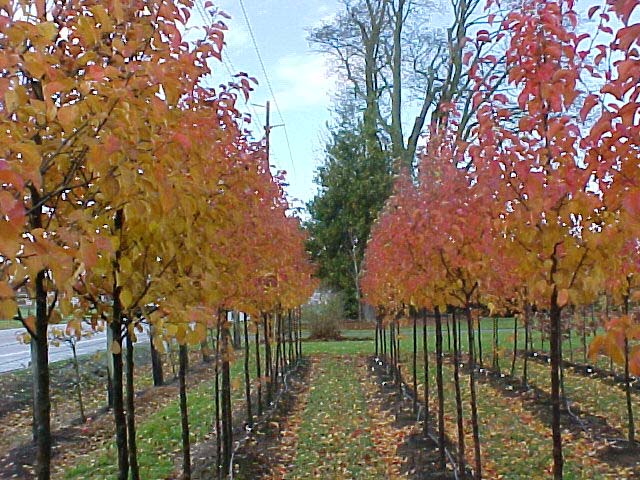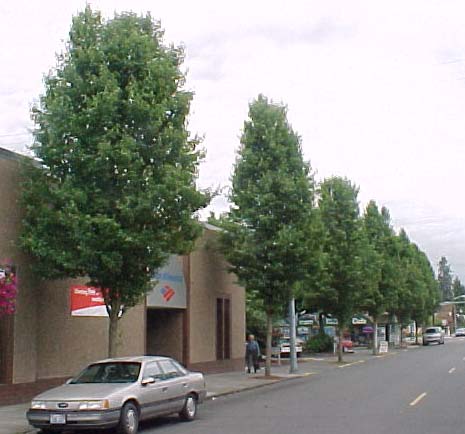Flowering Pear
Pyrus calleryana var.
 Some people feel that Flowering Pears are overused. If they are, there is good reason they are so popular. Most cultivars have exceptional qualities. They are very near to what I refer to as a ‘Bulletproof’ tree, with some exception. They have white flowers in the spring, sometimes quite impressive, followed by little or no fruit. In the fall, they display a wide range of brilliant colors, with yellows, red, purples, or dapples of all three. In addition, there is a wide range of sizes and forms, from the very narrow to relatively wide, to choose from. However, they may be most popular because of their transplantability, relative ease of establishment, and consistently high performance. They seem to grow and become established in a wide range of soils, including some of our typically poor urban soils. They are generally pest free, with most being resistant to Fireblight. I have only seen stress in pears caused by powdery mildew, usually where air circulation is poor. All of the trees become no more than moderate in size, so they are perfect for street tree use. Also, I have seldom observed the roots of flowering pear damage sidewalks.
Some people feel that Flowering Pears are overused. If they are, there is good reason they are so popular. Most cultivars have exceptional qualities. They are very near to what I refer to as a ‘Bulletproof’ tree, with some exception. They have white flowers in the spring, sometimes quite impressive, followed by little or no fruit. In the fall, they display a wide range of brilliant colors, with yellows, red, purples, or dapples of all three. In addition, there is a wide range of sizes and forms, from the very narrow to relatively wide, to choose from. However, they may be most popular because of their transplantability, relative ease of establishment, and consistently high performance. They seem to grow and become established in a wide range of soils, including some of our typically poor urban soils. They are generally pest free, with most being resistant to Fireblight. I have only seen stress in pears caused by powdery mildew, usually where air circulation is poor. All of the trees become no more than moderate in size, so they are perfect for street tree use. Also, I have seldom observed the roots of flowering pear damage sidewalks.
There are many cultivars, most of which are covered in Dirr’s “Manual of Woody Landscape Plants”. The following are the highs and lows of a few varieties I am familiar with:
'Aristocrat’ A wider form tree with branches at right angles to the central leader. The distinct characteristics of the leaf are its wavy edges. Fall color is not as reliable as others, but if you have the crown space, the Aristocrat is a fine selection. Older trees are reported to reach 40’ high by 25’ wide.
‘Autumn Blaze’ This tree is not recommended unless the site is very protected from wind. Although the form is round and the color is better than most of the pears, the limbs are incredibly brittle. Even if you get trees to the site undamaged during handling and shipping, winds will tear the tree apart for many years. From my experience, this one should be listed along with the original Bradford Pear.
 'Chanticleer’ (same as ‘Select’, ‘Cleveland Select’, and ‘Stone Hill’). The most popular, as well it should be, with its upright pyramidal growth, relatively good branch structure, and consistent qualities listed above. This cultivar was reported to reach 35’ high by 16’ wide after 15 years.
'Chanticleer’ (same as ‘Select’, ‘Cleveland Select’, and ‘Stone Hill’). The most popular, as well it should be, with its upright pyramidal growth, relatively good branch structure, and consistent qualities listed above. This cultivar was reported to reach 35’ high by 16’ wide after 15 years.
'Cambridge' Appears to have cleaner, more regular ascending limbs, smooth bark, with orange fall color. It is narrow like "Chanticleer'.
‘Capital’ Even narrower than the ‘Chanticleer’, so for a narrow space, this is the better choice. I have found the branch structure not to be as consistent or attractive in its winter show. The tree is said to grow to 32’ high by 8’ wide in 15 years.
‘Jack’ This tree is the smallest pear cultivar I have seen, growing to no more than 15’ tall by 10’ wide. This tree has a dense branch structure and very slow growth. Call for it more as spaces for trees get shorter and tighter. Check out the Jack Pear tree profile here.
‘Redspire’ This tree has a moderately pyramidal form, less than Chanticleer. I have found it to have some brittleness, thus somewhat susceptible to wind breakage.
'Bradfords’ are known for their extremely tight crotches and severe splitting apart as they mature. This cultivar was the first selection of Pyrus calleryana. Most of the older Bradfords have literally split apart. Avoid this one along with the ‘Autumn Blaze’
Contact us with your Flowering Pear experiences.
Pyrus calleryana var.
 Some people feel that Flowering Pears are overused. If they are, there is good reason they are so popular. Most cultivars have exceptional qualities. They are very near to what I refer to as a ‘Bulletproof’ tree, with some exception. They have white flowers in the spring, sometimes quite impressive, followed by little or no fruit. In the fall, they display a wide range of brilliant colors, with yellows, red, purples, or dapples of all three. In addition, there is a wide range of sizes and forms, from the very narrow to relatively wide, to choose from. However, they may be most popular because of their transplantability, relative ease of establishment, and consistently high performance. They seem to grow and become established in a wide range of soils, including some of our typically poor urban soils. They are generally pest free, with most being resistant to Fireblight. I have only seen stress in pears caused by powdery mildew, usually where air circulation is poor. All of the trees become no more than moderate in size, so they are perfect for street tree use. Also, I have seldom observed the roots of flowering pear damage sidewalks.
Some people feel that Flowering Pears are overused. If they are, there is good reason they are so popular. Most cultivars have exceptional qualities. They are very near to what I refer to as a ‘Bulletproof’ tree, with some exception. They have white flowers in the spring, sometimes quite impressive, followed by little or no fruit. In the fall, they display a wide range of brilliant colors, with yellows, red, purples, or dapples of all three. In addition, there is a wide range of sizes and forms, from the very narrow to relatively wide, to choose from. However, they may be most popular because of their transplantability, relative ease of establishment, and consistently high performance. They seem to grow and become established in a wide range of soils, including some of our typically poor urban soils. They are generally pest free, with most being resistant to Fireblight. I have only seen stress in pears caused by powdery mildew, usually where air circulation is poor. All of the trees become no more than moderate in size, so they are perfect for street tree use. Also, I have seldom observed the roots of flowering pear damage sidewalks.There are many cultivars, most of which are covered in Dirr’s “Manual of Woody Landscape Plants”. The following are the highs and lows of a few varieties I am familiar with:
'Aristocrat’ A wider form tree with branches at right angles to the central leader. The distinct characteristics of the leaf are its wavy edges. Fall color is not as reliable as others, but if you have the crown space, the Aristocrat is a fine selection. Older trees are reported to reach 40’ high by 25’ wide.
‘Autumn Blaze’ This tree is not recommended unless the site is very protected from wind. Although the form is round and the color is better than most of the pears, the limbs are incredibly brittle. Even if you get trees to the site undamaged during handling and shipping, winds will tear the tree apart for many years. From my experience, this one should be listed along with the original Bradford Pear.
 'Chanticleer’ (same as ‘Select’, ‘Cleveland Select’, and ‘Stone Hill’). The most popular, as well it should be, with its upright pyramidal growth, relatively good branch structure, and consistent qualities listed above. This cultivar was reported to reach 35’ high by 16’ wide after 15 years.
'Chanticleer’ (same as ‘Select’, ‘Cleveland Select’, and ‘Stone Hill’). The most popular, as well it should be, with its upright pyramidal growth, relatively good branch structure, and consistent qualities listed above. This cultivar was reported to reach 35’ high by 16’ wide after 15 years.'Cambridge' Appears to have cleaner, more regular ascending limbs, smooth bark, with orange fall color. It is narrow like "Chanticleer'.
‘Capital’ Even narrower than the ‘Chanticleer’, so for a narrow space, this is the better choice. I have found the branch structure not to be as consistent or attractive in its winter show. The tree is said to grow to 32’ high by 8’ wide in 15 years.
‘Jack’ This tree is the smallest pear cultivar I have seen, growing to no more than 15’ tall by 10’ wide. This tree has a dense branch structure and very slow growth. Call for it more as spaces for trees get shorter and tighter. Check out the Jack Pear tree profile here.
‘Redspire’ This tree has a moderately pyramidal form, less than Chanticleer. I have found it to have some brittleness, thus somewhat susceptible to wind breakage.
'Bradfords’ are known for their extremely tight crotches and severe splitting apart as they mature. This cultivar was the first selection of Pyrus calleryana. Most of the older Bradfords have literally split apart. Avoid this one along with the ‘Autumn Blaze’
Contact us with your Flowering Pear experiences.
Jim Barborinas
ISA Certified Arborist #0135
ASCA Registered Consulting Arborist #356 CLICK HERE FOR MORE TREE PROFILES
Certified Tree Risk Assessor #PNW-0327
ISA Certified Arborist #0135
ASCA Registered Consulting Arborist #356 CLICK HERE FOR MORE TREE PROFILES
Certified Tree Risk Assessor #PNW-0327
15119 McLean Road
Mount Vernon, WA 98273
(O) 360-428-5810
(M) 360-770-9921
(F) 360-428-1822
sales@urbanforestnursery.com
Mount Vernon, WA 98273
(O) 360-428-5810
(M) 360-770-9921
(F) 360-428-1822
sales@urbanforestnursery.com


